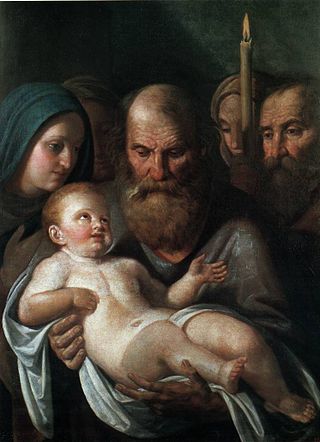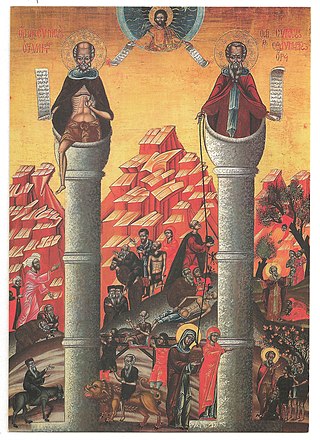Related Research Articles
Vincent of Lérins was a Gallic monk and author of early Christian writings. One example was the Commonitorium, c. 434, which offers guidance in the orthodox teaching of Christianity. Suspected of semi-Pelagianism, he opposed the Augustinian model of grace and was probably the recipient of Prosper of Aquitaine's Responsiones ad Capitula Objectionum Vincentianarum. His feast day is celebrated on 24 May.

Gennadius was the Patriarch of Constantinople from 458 until his death. Gennadius is known to have been a learned writer who followed the Antiochene school of literal exegesis, although few writings have been left about him. He is commemorated in the Eastern Orthodox Church on 17 November, but is not listed in the Roman Martyrology.

Simeon Stylites or Symeon the Stylite was a Syrian Christian ascetic, who achieved notability by living 36 years on a small platform on top of a pillar near Aleppo. Several other stylites later followed his model. Simeon is venerated as a saint by the Oriental Orthodox Churches, Eastern Orthodox Church, and Roman Catholic Church. He is known formally as Simeon Stylites the Elder to distinguish him from Simeon Stylites the Younger, Simeon Stylites III and Symeon Stylites of Lesbos.
A cowl is an item of clothing consisting of a long, hooded garment with wide sleeves, often worn by monks. It was developed during the Early Middle Ages. The term may have originally referred to the hooded portion of a cloak, though contemporary usage refers to an entire closed garment. A cowl is traditionally bestowed upon the monk at the time of making solemn, or lifetime, profession. Today, it is worn primarily by most Catholic and Anglican monks when participating in liturgical services.

Basilian monks are Greek Catholic monks who follow the rule of Basil the Great, bishop of Caesarea (330–379). The term 'Basilian' is typically used only in the Catholic Church to distinguish Greek Catholic monks from other forms of monastic life in the Catholic Church. In the Eastern Orthodox Church, as all monks follow the Rule of Saint Basil, they do not distinguish themselves as 'Basilian'.

Simeon at the Temple is the "just and devout" man of Jerusalem who, according to Luke 2:25–35, met Mary, Joseph, and Jesus as they entered the Temple to fulfill the requirements of the Law of Moses on the 40th day from Jesus' birth, i. e. the presentation of Jesus at the Temple.

Saint Nilus the Elder of Sinai was one of the many disciples and stalwart defenders of St. John Chrysostom.

Manahen was a teacher in the first century Christian Church at Antioch who had been 'brought up' with Herod Antipas.

Pammachius was a Roman senator who is venerated as a saint in the Eastern Orthodox and Roman Catholic Churches. He married Paulina. After her death, he gave himself up to works of charity.

Eulogius of Alexandria was Greek Patriarch of that see from about 580 to 608. He is regarded as a saint, with a feast day of September 13.

Florentina of Cartagena is venerated as a saint by the Catholic Church. Born towards the middle of the sixth century in Cartagena, Hispania, she and her family were actively engaged in furthering the best interests of Christianity.

Saint Simeon Stylites the Younger, also known as Simeon of the Admirable Mountain, is a saint in the Catholic Church and Eastern Orthodox Church.

Ursus of Solothurn was a 3rd-century Roman Christian venerated as a saint. He was associated very early with the Theban Legion and is recorded in the Roman Martyrology, with Victor of Solothurn on 30 September.
Saint Molua, , was an Irish saint, who was a Christian abbot in the Early Middle Ages. Saint Molua's feast day is on 4 August. He is venerated in the Catholic Church and Eastern Orthodox Church.
A list of people, who died during the 9th century, who have received recognition as Blessed or Saint from the Catholic Church:

Alypius the Stylite was a seventh-century ascetic saint. He is revered as a monastic founder, an intercessor for the infertile. During his lifetime he was a much sought-after starets.
Confessor of the Faith is a title given by some Christian denominations. In Catholicism and Eastern Orthodoxy, Christians who professed their faith in times of Christian persecution and therefore had to suffer persecution, expulsion, torture, mutilation and imprisonment, but not directly undergo martyrdom, are called confessors. Later, popes, bishops, abbots, kings and hermits were also counted among the confessors.
Asterius of Petra was a convert from Arianism, and later the Bishop of Petra.
Immaculate Heart of Mary Church, is a Catholic parish church in Cleveland, Ohio and part of the Diocese of Cleveland. It is a located on Lansing Ave. near East 66th St., in a part of the South Broadway neighborhood previously known as Warszawa, also referred to today as Slavic Village. Both the church and the area are GNIS named features. The church is in the neighborhood of, but not within, the area listed as Warszawa Neighborhood District on the National Register of Historic Places. The church, school, rectory, and convent buildings are listed together as a Cleveland Designated Landmark.

A stylite or pillar-saint is a type of Christian ascetic who lives on pillars, preaching, fasting and praying. Stylites believe that the mortification of their bodies would help ensure the salvation of their souls. Stylites were common in the early days of the Byzantine Empire. The first known stylite was Simeon Stylites the Elder who climbed a pillar in Syria in 423 and remained there until his death 36 years later.
References
- ↑ Thurston, Herbert; "St. Simeon Stylites the Younger", The Catholic Encyclopedia, Vol. 13, New York: Robert Appleton Company, 1912, 9 December 2021
 This article incorporates text from this source, which is in the public domain .
This article incorporates text from this source, which is in the public domain .
![]() This article incorporates text from a publication now in the public domain : Herbermann, Charles, ed. (1913). "St. Simeon Stylites the Younger". Catholic Encyclopedia . New York: Robert Appleton Company.
This article incorporates text from a publication now in the public domain : Herbermann, Charles, ed. (1913). "St. Simeon Stylites the Younger". Catholic Encyclopedia . New York: Robert Appleton Company.